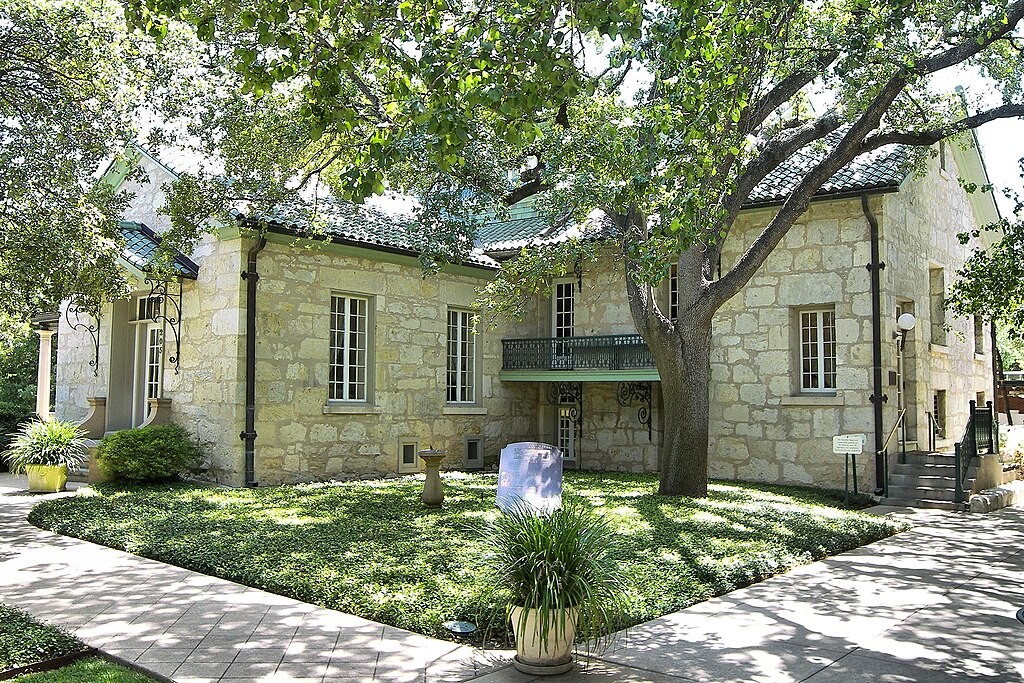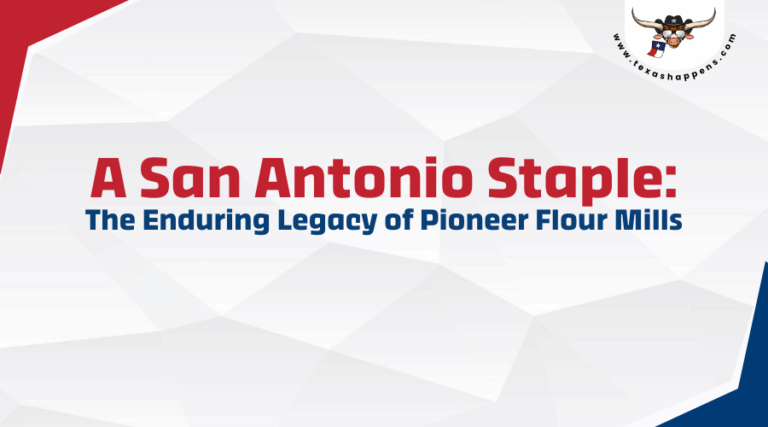Pioneer Flour Mills stands as San Antonio’s iconic industrial landmark, founded by German immigrant Carl Hilmar Guenther in 1851. You’ll recognize its white tower emblazoned with “Pioneer” near the River Walk. The mill evolved from water power to modern roller-mill technology as the Guenther family expanded operations through boom times and downturns.
Today, the historic Guenther House offers a glimpse into this 170-year legacy that grew from a hill-country mill to a cornerstone of Texas food manufacturing and culinary heritage.
From German Immigrant to Texas Industrialist: The Story of Carl Hilmar Guenther
A young German millwright’s bold decision to leave his homeland without parental consent would eventually transform Texas’s milling industry. At 23, Carl Hilmar Guenther embodied self-made entrepreneurship, bringing specialized milling knowledge from Germany to America in 1846. His journey took him through the Midwest and Louisiana before settling in Texas.
Viewing America as a land of opportunity, Guenther established his first grist and flour mill near Fredericksburg around 1851, drawing on family support and his training. His German-American identity influenced his business approach, combining Old World craftsmanship with New World innovation. He built the original Live Oak Creek mill, establishing his first foothold in the Texas milling trade.
After a devastating drought in 1858, he strategically relocated to San Antonio, recognizing its growing population and more reliable water supply—a decision that would cement his legacy in Texas industry. Like the Texas Longhorn Herd that symbolizes the state’s resilience, Guenther’s pioneering spirit represented the determination that helped shape Texas’s economic development.
The Mill on the River: Choosing San Antonio as Home
View this post on Instagram
The decision to relocate from Fredericksburg to San Antonio in 1859 marked a turning point in Guenther’s enterprise. Facing competition and climate risks, C. H. Guenther purchased land just south of downtown along the river, positioning himself to serve a growing urban market.
This location offered critical advantages, enabling water-powered equipment that later transitioned to turbines and auxiliary engines essential for higher-capacity milling. The site’s proximity to freight routes improved distribution of both grain and finished flour while providing necessary process water. Similar to Houston’s development, San Antonio’s industrial growth was closely tied to transportation improvements and resource utilization.
As San Antonio expanded, so did the mill, replacing early structures with reinforced-concrete facilities in the early 20th century, followed by a major grain elevator in the 1920s—all testaments to Guenther’s foresight in choosing this riverside location. The mill became one of the city’s enduring flour operations, underscoring Guenther’s role in San Antonio’s industrial rise.
Evolution of Milling Technology: From Water Wheels to Steam Power
Transformations in milling defined the 19th century as Pioneer Flour Mills advanced with industry innovations. Water-powered mills, while effective, faced seasonal limits and maintenance demands. The adoption of shafting, belts, and gearing improved the turning of stones and later supported roller systems for more consistent output.
By the late 1800s, steel rollers and auxiliary steam/engine power allowed year-round operation with improved efficiency and quality. This focus on throughput and consistency—without sacrificing flour performance—mirrors how other Texas food brands like Church’s Texas Chicken modernized as they scaled beyond their origins.
The Iconic White Tower: Architectural Landmarks of Pioneer Flour Mills
View this post on Instagram
Rising above San Antonio’s near-South Side since the 1920s, Pioneer Flour Mills’ white tower stands as both an architectural marker and functional centerpiece. The concrete, elevator-and-mill complex—emblazoned with “Pioneer” (and for many years “White Wings”)—was among the most prominent industrial silhouettes in the city.
Beyond its visual impact, the tower houses bins and handling systems crucial to the milling process. Inside this landmark facility, grain is cleaned, conditioned, and precisely blended before being milled and packaged. It’s strategically positioned near the historic Guenther House and today’s River Walk, creating a complex integral to local heritage tourism.
While retaining its industrial role, preservation and ongoing maintenance have ensured the landmark continues to symbolize San Antonio’s industrial past. You’ll spot it as a wayfinding beacon for visitors, reinforcing the mill’s century-long presence in the community.
Family Legacy: How the Guenthers Shaped San Antonio’s Industrial History
When Carl Hilmar Guenther established his first mill in 1851 near Fredericksburg, he couldn’t have imagined the enterprise his family would build. After relocating to San Antonio in 1859, the Guenthers transformed their operation into a fixture of the city’s economy.
Under Erhard Guenther and subsequent generations, the family expanded capacity, adopted roller-mill technology, and supported civic causes through philanthropy that benefited local institutions. Their community leadership reflected a commitment to San Antonio’s development that went far beyond commerce. By the early 20th century, the company’s modernization positioned it for regional distribution and long-term growth.
Feeding a Growing Nation: Product Innovation Through the Decades
Throughout its history, Pioneer Flour Mills embraced innovation to meet demand. The shift from millstones to steel rollers in the late 19th century revolutionized output and consistency, while engine power freed production from seasonal river levels.
They didn’t stop at flour—baking mixes, biscuit and gravy mixes, and other pantry staples expanded their market reach.
You’d recognize their commitment to brand development across multiple labels, including “Pioneer” and “White Wings,” which extended the company’s presence in Texas kitchens.
Their robust sourcing and distribution helped ensure year-round milling and reliable supply. During World War I, the company supported the region’s needs, demonstrating its ability to pivot in national challenges. The signature white elevator completed in the 1920s became a symbol of both industrial prowess and community presence.
Surviving Economic Challenges: Pioneer Mills During the Great Depression
Despite facing one of America’s most catastrophic economic downturns, Pioneer Flour Mills persevered through the 1930s. The company’s adaptable model proved vital as it emphasized consumer convenience products alongside core flour, supporting households seeking reliable, affordable staples.
Strategic regional expansion helped, too. Warehousing and distribution links across South and Central Texas strengthened logistics while diversifying the customer base beyond San Antonio. Modernization continued, building on the momentum of the 1920s—when the elevator and upgraded mill systems were put in place. This blend of product focus and market reach supported Pioneer’s resilience during difficult times.
Beyond the Mill: The Guenther House as a Cultural Destination

While Pioneer Flour Mills cemented its economic resilience in hard times, the company’s legacy extends beyond industry. The Guenther House, constructed in 1860 as Carl Hilmar Guenther’s residence, now serves as a captivating window into German-Texan heritage.
The home’s transformation from private residence to public museum offers authentic interpretation of immigrant enterprise. When you visit, you can enjoy dining in historic spaces while exploring the Guenther family’s milling story. Early 20th-century renovations reoriented the house within the expanding mill complex. Listed on the National Register of Historic Places, it remains a compelling testament to German-Texan entrepreneurship and architectural preservation—including its green tile roof and elegant upper-floor rooms.
Pioneer’s Place in San Antonio’s Historic Southtown District
The iconic white elevator of Pioneer Flour Mills stands as a sentinel in San Antonio’s historic Southtown district, marking over 160 years of industrial presence along the river. As you explore, you’ll see how Pioneer’s integration with Southtown helped shape the neighborhood’s identity and development.
Pioneer’s impact extends beyond manufacturing, contributing to Southtown’s evolution in four ways:
- Anchoring the district’s industrial heritage while supporting its cultural transformation
- Driving heritage tourism through the Guenther House museum and restaurant
- Connecting the King William Historic District with the industrial corridor
- Demonstrating how a family business can adapt while preserving historical significance
What began as a frontier mill in 1851 has grown into a leading food producer while remaining faithful to its historic roots. You’re witnessing living history when visiting this cornerstone of San Antonio’s development from frontier town to modern city.


